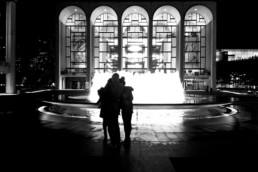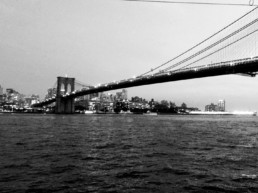Another photo/haiku pairing from New York City. This time with an operatic backstory.

Three friends silhouette
fountain light Lincoln Center
overpriced cocktails.
New York City
October 2018
One of my primary objectives on a recent trip to New York was to see a Metropolitan Opera production of La Bohème. Somehow in recent years (probably a signal of my advancing middle-age,) I’ve developed an odd but persistent fascination with opera. This might be understandable if I actually lived in a place where one could regularly attend, but living in Montana as I do, my opera-going habits are somewhat under-developed. When I do watch opera, it is frequently in a 75-seat theater at Missoula’s Roxy Theater which screens them. That experience has it’s own quirky Montana charm, as I sit in the little theater with 3-5 other people and watch opera while munching on organic popcorn and sipping $2 Hamm’s beer from the can. I can’t honestly think of a better way to spend a cold winter night. But seeing a production live at Lincoln Center is a completely different experience notable not only for the absence of popcorn and the $17 Stella Artois served in fancy (plastic) beer glasses.
The Opera house at Lincoln Center is grand, but in a very Twentieth-century New York way. The venue intentionally lacks the architectural neoclassicism present at Teatro alla Scala in Milano or the Staatsoper in Vienna (both mostly rebuilt after being destroyed in World War II). Compared to the opera houses of Paris (the beautiful baroque and neoclassical mish-mash that is Palais Garnier or the sleek modernism of Opera Bastille,) Lincoln Center appears from most angles more like a boxy urban cineplex than an opera house. But the travertine-clad facade and the clean-lined Art Deco interior are impressive even without the 30-foot Marc Chagall tapestries in the lobby.
Manhattan is undergoing a building boom, and much of the city seems to be under the scaffold. New giants are quickly transforming the Midtown skyline and the rumbling sounds of construction underlie the constant sounds of city life like an orchestra with an over-chaired section of didgeridoos. Entering the opera from this soundscape is dramatic. The sounds of Manhattan dissolve as one enters the Met lobby, filled with the voices of excited opera-goers, bartenders, and ticket handlers. The audience is diverse, but one is taken by the number of young (under 30) people who seem to be drawn to the opera in herds.
The opera is the last place I would expect to feel old, but opera is not what it used to be. Part of my fascination with opera is that it is entering a renaissance of sorts. I would not say we are living in a Golden Age of Opera, for that might suggest there is a wealth of new writing. There is some interesting writing happening in opera, but much of the production remains the classics. The renaissance is in production, and it derives entirely from a wave of incredible young talent which is driving the performances. For much of my lifetime, popular opera was defined by a small group of male tenors (Domingo, Carreras and Pavarotti), and most of my fellow Generation-X were more attuned to Elvis Costello than Enrico Caruso, Maria Callas or even the then still active Leontyne Price. But the opera today is young and vibrant, and while it may be surprising to some, it is not out of place to find groups of eclectically dressed millennials talking about the latest episode of the Met Opera Guild Podcast during the intervals.
In this context of young talent, the staging of La Bohème I attended did not disappoint. The orchestra under the direction of conductor James Gaffigan was exceptional, and a cast of talented young performers (Nicole Car as Mimi, Angel Blue as Musetta, Etienne Dupuis as Marcello, Davide Luciano as Schaunard and Ryan Speedo Green as Colline) brought the performance to life. Combined with the incredible technical spectacle of the Met’s set design and staging, the entire production was immensely rewarding.


